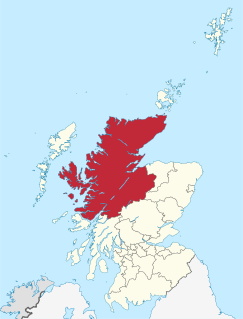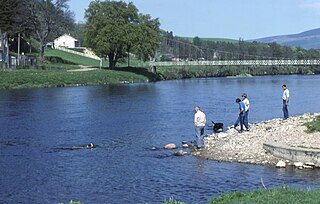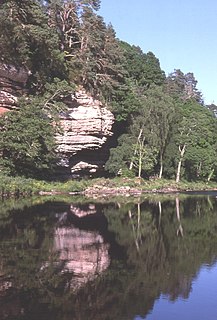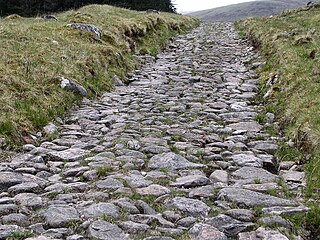
The River Nairn (Scottish Gaelic : Narann / Abhainn Narann) is a 35 mile long [1] river in the Scottish Highlands.

The River Nairn (Scottish Gaelic : Narann / Abhainn Narann) is a 35 mile long [1] river in the Scottish Highlands.
The hydronym Nairn is Pictish in origin. [2] The name may involve *Naverna, of which the ultimate genesis is the Celtic root *(s)naf meaning "flow, swim" (c.f. Welsh nawf). [2] The toponym Nevern in Wales may be identically derived. [2]
The River Nairn rises in the Monadhliath Mountains and flows northeast through Strathnairn to enter the Moray Firth at Nairn. The headwaters of the Nairn, the Allt Mor and Crom-allt Beag drop steeply down the western slopes of Càrn Ghriogair, their combined waters flowing beneath the B851 road and turning northeastwards. The young River Nairn is soon joined by the diminutive River Brin on the right bank and later by a burn draining the sizeable Loch Duntelchaig on the left. The River Farnack is the next right bank tributary, followed by the Craggie Burn near the A9 road crossing of the Nairn at Daviot.

The river continues to flow past Drummossie Moor which lies to its northwest and indeed past Culloden Moor, site of the battle in 1746. Passing beneath the Culloden Viaduct carrying the mainline railway between Perth and Inverness, it then runs between Culloden Forest and Assich Forest to pass beneath the B9090 road between Clephanton and Cawdor. Its last major tributary, the Allt Dearg joins from the right and the river continues northeastwards passing beneath the B9090 once again before reaching the town of Nairn.
The Allt Dearg and its major tributary the Riereach Burn rise on the northern slopes of Carn nan Trì Tighearnan and flow north to meet the Nairn. [3]

Highland is a council area in the Scottish Highlands and is the largest local government area in the United Kingdom. It was the 7th most populous council area in Scotland at the 2011 census. It shares borders with the council areas of Aberdeenshire, Argyll and Bute, Moray and Perth and Kinross. Their councils, and those of Angus and Stirling, also have areas of the Scottish Highlands within their administrative boundaries.

Inverness is a city in the Scottish Highlands. It is the administrative centre for The Highland Council and is regarded as the capital of the Highlands. Historically it served as the county town of the county of Inverness-shire. Inverness lies near two important battle sites: the 11th-century battle of Blàr nam Fèinne against Norway which took place on the Aird, and the 18th century Battle of Culloden which took place on Culloden Moor. It is the northernmost city in the United Kingdom and lies within the Great Glen at its northeastern extremity where the River Ness enters the Beauly Firth. At the latest, a settlement was established by the 6th century with the first royal charter being granted by Dabíd mac Maíl Choluim in the 12th century. Inverness and Inverness-shire are closely linked to various influential clans, including Clan Mackintosh, Clan Fraser and Clan MacKenzie.

The River Ness is a river in Highland, Scotland, UK. It flows from Loch Dochfour, at the northern end of Loch Ness, north-east to the mouth of the Beauly Firth at Inverness, a distance of about 6 miles, with a fall in height of about 16 metres. The river is the origin of the name of Inverness which is from Scottish Gaelic: Inbhir Nis, meaning "Mouth of the Ness".

The County of Nairn is a historic county, registration county and lieutenancy area of Scotland. The county was used for local administration until the county council, based at the county town of Nairn, was abolished in 1975 under the Local Government (Scotland) Act 1973, the area becoming one of the eight districts of the two-tier Highland region. This arrangement ended in 1996 when the Highland council area was made a unitary authority.

Beinn Dearg is the fourth highest of the Torridon Hills in the highlands of Scotland. Beinn Dearg offers all the typical features of a Torridon hill, with steeply terraced rocky sides dissected by near vertical gullies. The summit ridge is an airy crest that offers some easy scrambling; alternatively this can be avoided by following a path that traverses the terraces on the southern side.

The River Spey is a river in the northeast of Scotland. It is the eighth longest river in the United Kingdom, as well as the second longest and fastest-flowing river in Scotland. It is important for salmon fishing and whisky production.

The River Findhorn is one of the longest rivers in Scotland. Located in the north east, it flows into the Moray Firth on the north coast. It has one of the largest non-firth estuaries in Scotland.

Aberchalder is a small settlement and estate at the northern end of Loch Oich in the Scottish Highlands and is in the Highland council area of Scotland. It lies on the A82 road and is situated in two parishes, Boleskine and Kilmonivaig. Fort Augustus is within 5 mi (8.0 km).

Càrn Mairg is a Scottish mountain located 18 km west of Aberfeldy in the Perth and Kinross council area. It stands on the northern side of Glen Lyon in a cluster of four Munros known as the Càrn Mairg group which are situated in a semi circle around the Invervar Burn.

The River Truim is a right bank tributary of the River Spey in the Scottish Highlands. Its headwaters meet to the north of the Pass of Drumochter and flow northwards as the Truim past the dam at the northern end of Loch Ericht and through the village of Dalwhinnie, highest village in the Scottish Highlands. The distillery at Dalwhinnie producing Dalwhinnie Single Malt is also the highest in Scotland. The waters of its most significant tributary, the Allt Cuaich, are diverted in part along an aqueduct to Loch Ericht. The river continues north-northeastwards down Glen Truim, over the Falls of Truim and on to meet the Spey 2.5 miles (4 km) southwest of Newtonmore. It is closely followed for almost its entire length by both the A9 road and the mainline railway from Perth to Inverness.

The River Garry is a major tributary of the River Tummel, itself a tributary of the River Tay, in the traditional county of Perthshire in the Scottish Highlands. It emerges from the northeastern end of Loch Garry (56.8193°N 4.2311°W), just to the southeast of the Pass of Drumochter, and flows southeastwards and eastwards down Glen Garry to the narrow Pass of Killiecrankie beyond which it joins the Tummel (56.7182°N 3.7790°W).

The River Fiddich is a right bank tributary of the River Spey in northeast Scotland. It rises on the eastern slopes of Corriehabbie Hill in Glenfiddich Forest and flows northeastwards beneath the A941 road, past Auchindoun Castle to a sharp bend adjacent to the A920 road where it turns westwards to flow to Dufftown. The Fiddich is joined on the eastern edge of the town by the Dullan Water which drains Glen Rinnes. Their combined waters then flow generally northwestwards, passing beneath the B9014 road near Balvenie Castle and then the A95 at Craigellachie immediately before meeting the Spey.

The River Feshie is a major right bank tributary of the River Spey in northeast Scotland. It rises in the remote countryside of the Glenfeshie Forest, flowing initially eastwards before turning sharply to the northwest as a result of the capture of the waters of Geldie Burn. After gaining the waters of the River Eidart on its right bank and dropping down into Glen Feshie, it flows northwards through the wooded glen and is often braided in nature. It is joined by several burns which descend steeply from the Cairngorm plateau to the east and, on its left bank, by the Allt Chomhraig near Balachroick. The river passes beneath the B970 road at Feshiebridge and after a further 1.5 miles (2.5 km) it joins the Spey near the village of Kincraig.

The River Druie is a right bank tributary of the River Spey in northeast Scotland. The Druie tributary, Am Beanaidh, emerges from Loch Einich and flows north through Gleann Einich. To its east, the Allt Drùidh flows northeastwards out of the Lairig Ghru. At their confluence in Rothiemurchus Forest some 4 miles (6 km) southeast of Aviemore, the Druie is born. Their combined waters flow as the River Druie beneath the Cairngorm Club Footbridge and on to meet the waters of the River Luineag immediately above the bridge carrying the B970 road over the river at Coylumbridge. The Druie flows a further 1.5 miles (2.5 km) past Inverdruie to meet the Spey at the southern end of Aviemore. The Luineag emerges from Loch Morlich within the Glenmore Forest Park and receives all the drainage from the northern slopes of Cairn Gorm.

The River Calder is a left bank tributary of the River Spey in the Scottish Highlands. Its headwaters are the an t-Allt Ballach, Allt an Lochain Dubh and Allt Madagain which drain the mountain slopes at the southeastern corner of the Monadhliath. Their waters are added to by those of the Allt Fionndraigh and Allt a' Chaorainn dropping down into Glen Banchor from the north. The river turns southeastwards and skirts the western edge of Newtonmore, running beneath the A86 road before joining the Spey at Spey Bridge.

A network of military roads, sometimes called General Wade's Military Roads, was constructed in the Scottish Highlands during the middle part of the 18th century as part of an attempt by the British Government to bring order to a part of the country which had risen up in the Jacobite rebellion of 1715.
Strathnairn is an area of the Scottish Highlands approximately 8 miles southwest of Inverness, bordering the Monadhliath Mountains. The Strath's borders reach to the north where Clava cairn and the Battle of Culloden lie, following the River Nairn south through Daviot, Farr, Brin, Croachy, and finally ending near Dunmaglass.

The Culloden Viaduct, known also as the Nairn Viaduct, the Culloden Moor Viaduct or the Clava Viaduct is a railway viaduct on the Highland Main Line, to the east of the city of Inverness, in the Highland council area of Scotland.
Gairn Water, situated in the Cairngorms National Park, is a river in Scotland with an elevation of 899 feet and a length of 4.75 kilometres.
| Wikimedia Commons has media related to River Nairn . |